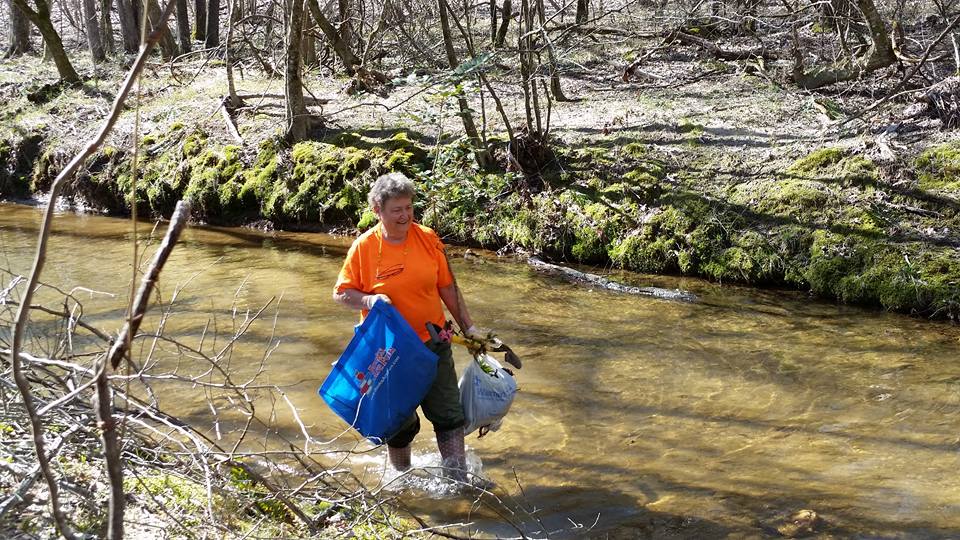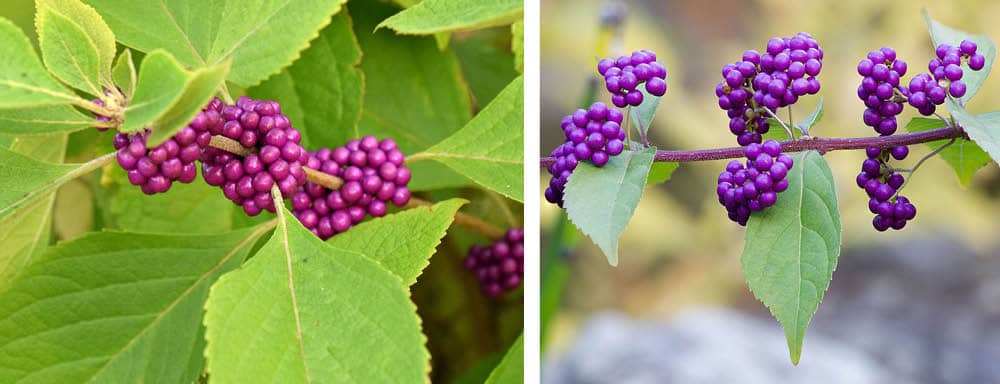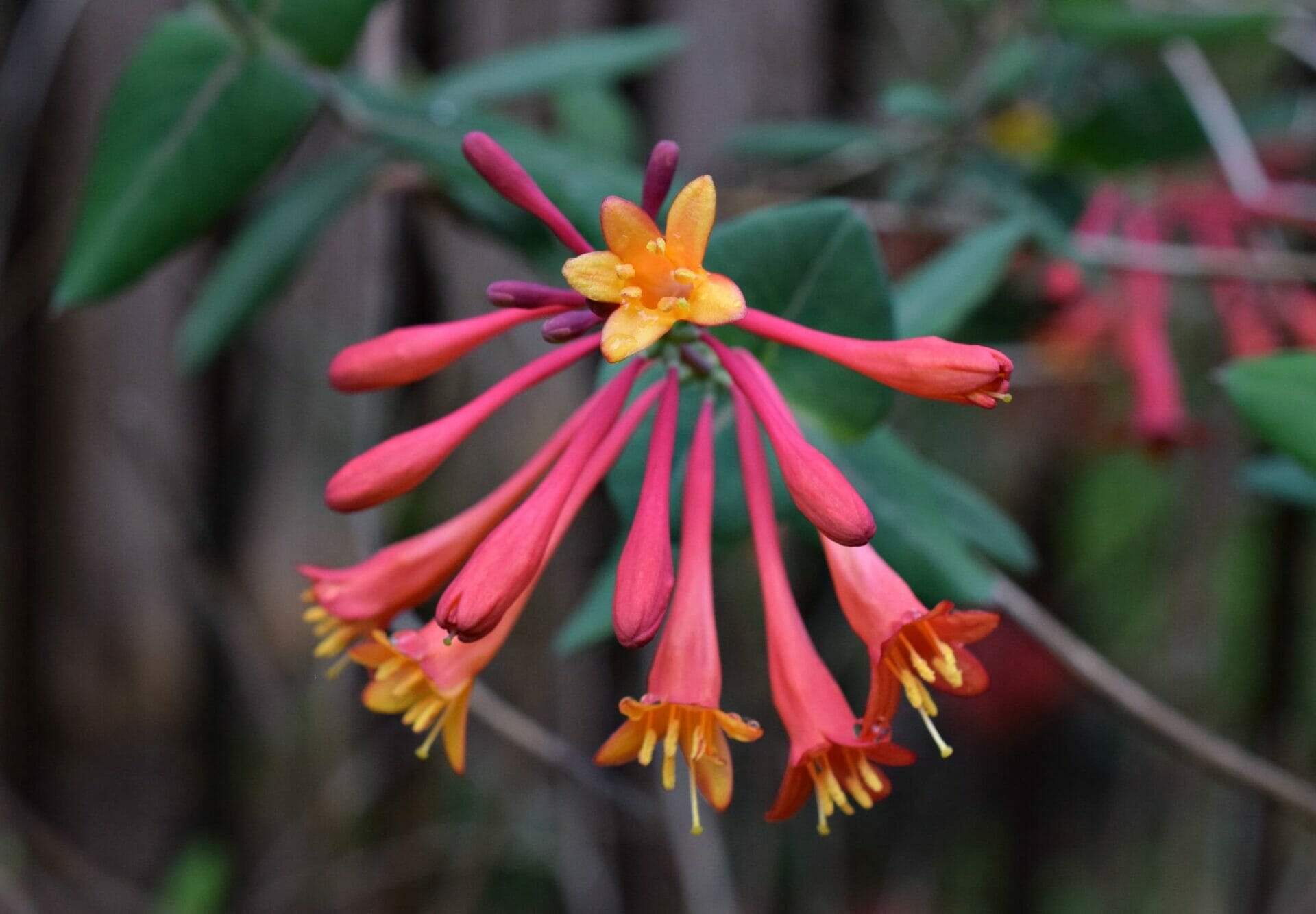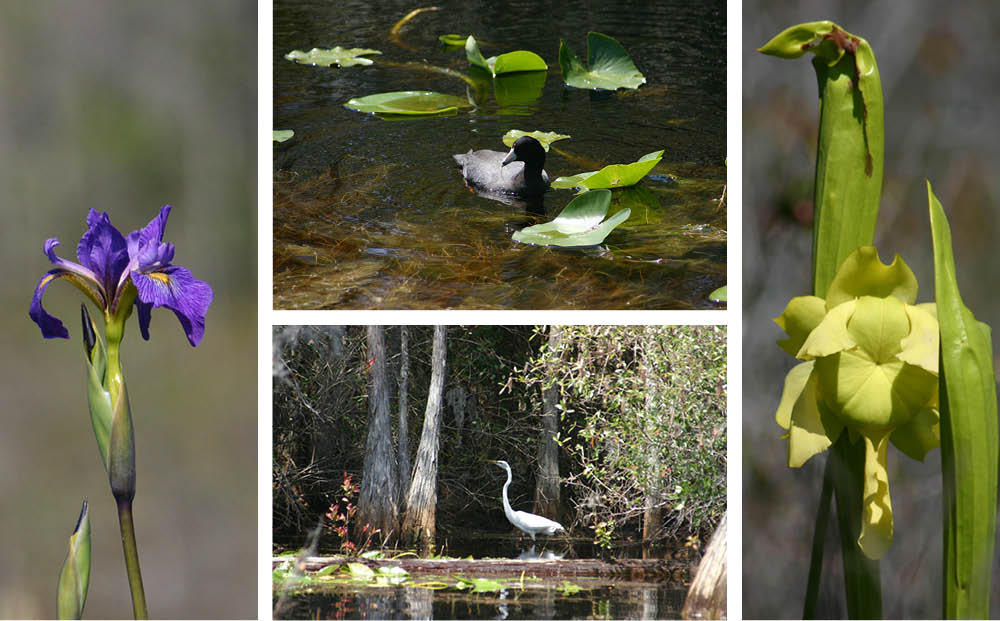September Atlanta Meeting
Interested in learning more about how to capture rainwater using native wetland plants? Join us for a spectacular presentation from the team that designed the McDaniel Branch Wetlands in southwest Atlanta, a landscape that captures stormwater and where native plants, pollinators, and birds now thrive. The wetlands duplicate natural processes and feature ponds and pond edges with an abundance of easily available native plants, including wild rye, river oats, brown-eyed susans, ironweed, Joe-pye weed, native aquatics, American hornbeam, American beautyberry, buttonbush, spicebush, and many more. Learn about the challenges of designing and installing rainwater landscapes and how they were overcome in this highly successful landscape.
We are especially fortunate that many of the site designers will provide their perspectives, including Michael Kidd, landscape architect; Andrew Walter, COA Department of City Planning; Larry Tucciaraone, COA Department of Watershed Management; and Brian Williams, Trees Atlanta and the Atlanta Beltline.
We look forward to seeing you there! Social hour begins at 6:30, and the meeting begins at 7:00. Meetings are always FREE and open to the public. Tell the Atlanta Botanical Gardens staff you’re there for the GNPS meeting and the garden entrance fee will be waived. GNPS member carpoolers earn discount parking vouchers — be sure to sign in when you arrive.
Chapter News: West Georgia
Carol Hight

Left: Reggie Jarrell stands next to the new fence that he and Frank Bennett installed. Right: Mike Inglis prepares the adjacent meadow for solarizing by cutting back all growth to the soil line.
Despite the higher than normal temperatures and the lack of measureable rain for five weeks, the West Georgia Chapter has had a busy summer. Members Frank Bennett and Reggie Jarrell finished installing the next section of the split rail fence (an effort to keep the county workers from mowing our flowers when they mow the rest of the meadow.) Following a donation of Asclepias tuberosa seedlings from Monarch Watch, we covered a large area of this newly fenced area of the overgrown meadow with plastic to solarize the soil. The area was overrun with non-native grasses up to our knees and too much goldenrod. The goldenrod has been allowed to do it’s thing for years and it has spread over a couple of acres. Now that we have had a nice rain, we will begin removing the plastic and start planting the milkweed, along with other good pollinator plants that will do well on the dry hillside. We will top this off with a good layer of mulch, in hopes of keeping the undesirable plants at bay.
Our seed propagation workshop got off to a good start in July with visits to three gardens that feature native plants. We collected some seeds that will be used in the next class in September, which will be a training class on collecting, cleaning and storing seeds. Each participant will take home a supply of several kinds of native wildflower seeds, along with collection bags, storage bags, sieves for cleaning seeds, and labels for their stored seeds. Our final two classes will be held in January and March, with Elaine Nash teaching techniques for seed propagation followed by a day of planting seeds for each person to take home.
In August, our speaker was Stephanie Vogler-Piper who presented The Piedmont Moth-erland, a discussion of the many kinds of moths found in Georgia.

Carol Hight participates in the streamside plant rescue at the Richland project.
On two successive Sundays, we hosted rescues at Richland, the last rescues before the entire property is being stripped of trees, then scraped. We dug for 4-7 hours on these rescues and were pleased to be able to rescue along two of our favorite streams, collecting bags of galax, ferns, tiarella, rattlesnake weed, fly poison, and many others. I think the clearing was to be started the next day after our second rescue. We made a good contact who works for the development company handling the Richland project. She said that she would try to keep us informed about new projects as she learns about them.
Next up for us is our Fall Festival, The Asters or Georgia. Ellen Honeycutt will do one session — Identifying Asters and Using them in Your Landscape. The second speaker will be Jim Ozier from the Environmental and Natural Resources group of the Georgia Power Company. He will talk about the status and conservation of the Georgia Aster. We will have vendors on hand with native plants and various garden art. The meeting will be at the Carrollton Ag Center on September 14, with registration at 8:30 am and the program beginning at 9:00. We hope to see many of our GNPS members from across the state at the program.
Plant Spotlight: Do You Have the Native Beautyberry?
Ellen Honeycutt

Compare the American beautyberry (Callicarpa americana) on the left to an Asian species (C. japonica) on the right. Note how large the leaves are, relative to the berries, and how close the berries grow to the stem of the American species. [Left photo by Ellen Honeycutt, right photo Purple beautyberry, Daisen Park, Sakai, Osaka." by Laitche is licensed under CC BY-SA 4.0.]
American beautyberry (Callicarpa americana) is a stunning plant in the fall, and I know that many of you agree because it was our member-selected Plant of the Year in 2018. It is a full-sun shrub that is generally deer-resistant and native throughout Georgia. Lately I have seen several people mention that they have American beautyberry, only to show a picture of one of the Asian species (C. japonica from Japan, or C. dichotoma and C. bodinieri from China). This plant was shared with them or even purchased (hopefully not from a nursery) with the designation that it was American beautyberry.
To help ensure that you can recognize the native species, here are 3 characteristics that you can check:
In addition to these visual characteristics, if the plant is sold with a cultivar name, it is more than likely to be non-native as there are many more cultivars of those species. While the birds certainly do like the berries of all species, preserving the genetic value of our native species means it’s worth checking on whether you’re getting the American one or not. There are also small reports of C. dichotoma escaping cultivation into the wild.
GNPS Plant of the Year Nominations Open October 1
Valerie Boss

GNPS 2019 Plant of the Year, Coral Honeysuckle (Lonicera sempervirens). Photo by Ellen Honeycutt.
Georgia is rich in beautiful and ecologically significant native plants. Each year, the GNPS recognizes one of these species as being particularly worthy of public notice. If there is a native plant we have not featured in previous years that you think is exceptional, we encourage you to nominate it this autumn for GNPS Plant of the Year 2020.
Nominations will open at 7 pm sharp on October 1, 2019, and continue until six acceptable nominees have been submitted. Premature submissions will not be considered. All nominated species must be Georgia natives and hardy enough to survive in most gardens. We urge you to nominate a plant that isn’t commonly grown in gardens and landscapes. There are some fantastic native treasures out there that many people aren’t aware of … yet. This is your chance to bring attention to an underutilized, but special, species. The winning species will be printed on our popular Plant-of-the-Year t-shirts.
Nomination instructions will be posted on the GNPS website in mid-September after the plant sale, as well as in the October 1st newsletter. You must be a member to nominate a plant, so check now to make sure your membership is up to date! You can check by logging in to gnps.org, going to the Member Portal, and selecting "Manage Membership," then "Renew or View Membership" from the menus on the right. If you're not a member, please JOIN and be a part of our native plant community that is making a difference across Georgia.
Hunting and Conservation
Heather Brasell
As we think about conservation, it seems worthwhile to consider the nexus of hunting and plant conservation. I come from New Zealand where the only native terrestrial mammals are a couple of bat species. Uncontrolled population growth of introduced mammals, such as opossum and several ungulate species, wreaked havoc on the native ecosystems through overbrowsing and subsequent erosion. However, I’m not going to dwell on the consequences of overpopulation on the ecosystems, on collisions with cars, or on health of the individual animals. I want to focus on how much people like us, who love plants and want to conserve natural communities, owe to hunters and hunting organizations.
First, a lot of public land bought and managed for conservation of natural communities is funded by hunting and fishing. Under the Federal Aid in Wildlife Restoration Act of 1937, most often referred to as the Pittman-Robertson Act, there is a 10-11% excise tax on hunting equipment. The funds go directly to the Secretary of the Interior to distribute to state fish and game departments based on the area of the state and its number of licensed hunters. The funds are used to acquire or lease land, manage wildlife habitats, conduct research and surveys, and provide safety training. These funds allow Georgia Department of Natural Resources (DNR) to conduct control burns and to manage invasive species – practices essential to plant conservation. Because the Pittman-Robertson Act was so successful, a similar act was written for fishing in 1950. The Federal Aid in Sports Fish Restoration Act of 1950 is usually known as the Dingell-Johnson Act. In 2019, Georgia received over $23 million from the Pittman-Robertson funds and over $8 million from Dingell-Johnson funds. As a landowner, I benefit from DNR educational programs and technical assistance that increase my effectiveness as forest steward.

When you see a tree stand in the forest, that is conservation at work, both in the financial support through fees and the individual actions of hunters, such as the installation of a turtle crossing sign.
Second, hunting organizations are heavily invested in habitat conservation. This is exemplified by National Wild Turkey Federation slogan “Save the habitat, Save the hunt,” an outlook shared by other organizations such as Ducks Unlimited and Quail Forever. These organizations raise funds for conservation and education, providing technical assistance for landowners and promoting opportunities for young people to enjoy outdoor recreation. Erin Cork, wildlife biologist for Quail Forever (QF), organized a Pollinator Census event at the Gaskins Forest Education Center. This is just one of QF’s initiatives for pollinator conservation. They are considered a leader in Monarch conservation through USDA’s Working Lands for Wildlife. Here is how Erin described the organization. “QF is known as The Habitat Organization and works with private land owners to improve early successional wildlife habitat for quail and other birds, state-threatened species like the Gopher tortoise, pollinators, and other upland species which rely on the same types of habitat management.” Jessica McGuire, Working Lands for Wildlife Coordinator for QF, refers to quail as an “umbrella species.” Many species of plants and animals benefit when we restore understory and conserve quail habitat.
Third, individual hunters contribute to conservation. Leasing property for hunting provides funds I need to conduct control burns and treat invasive species. Hunters love being in the woods and many are avid conservationists. As they sit in their tree stands, they listen to the birds, observe seasonal changes in the habitat, and experience the coming and going of daylight and changes in weather. Here are a few anecdotes from some of our hunters. One hunter posted a “Turtle Crossing” sign where a gopher tortoise burrow was next to a trail. He probably couldn’t find a “Tortoise Crossing” sign. Another sent me a photo of dying red bay trees – the first sign of laurel wilt disease on our property. Another sends me photos of plants to identify. Another phoned me excitedly to take me to a gorgeous fungus he had found. At the beginning of each hunting season, I tell the hunters about specific invasive plants to look out for and they become part of my early-detection network. Some of them carry a spray bottle with herbicide to treat Japanese climbing fern they come across, so they are part of my eradication program.
As a native plant enthusiast and ecosystem conservationist, I am deeply grateful for the role played by hunters and hunting organizations in conservation.
Okefenokee Ecology Threatened by Mining
Charles Seabrook

The Okefenokee is essential to southeastern ecology, supporting a variety of native plants and wildlife, some familiar, and some much less familiar. [Photos by Tom Collins.]
An Alabama-based company, Twin Pines Minerals, has applied for a permit from the Army Corps of Engineers to strip-mine for titanium and zirconium in a 12,000-acre tract near the eastern edge of the Okefenokee National Wildlife Refuge. To get to the ores, miners would have to dig an average of 50 feet in a geological feature known as Trail Ridge. Botanists, environmentalists, wildlife biologists and others warn that such a massive operation so close to the Okefenokee poses substantial risks of ruining the famed wetland’s hydrology and causing ecological disaster. “Should impacts occur they may not be able to be reversed, repaired, or mitigated for,” said the US Fish and Wildlife Service.
A similar proposal 20 years ago by DuPont to open a huge mine next to the refuge was halted amid protests from environmental organizations.
The 438,000-acre Okefenokee’s ecological importance cannot be overstated. It teems with birds, reptiles, amphibians and other wildlife, including several protected species. Botanically, a high diversity of habitats results in an array of plant species. Grasses, sedges, ferns, and rushes thrive in the drier areas; water lilies, pickerel weed, yellow-eyed grass, and golden club are found in wetter sites. Many kinds of shrubs and trees grow on floating mats of peat. Evergreen shrubs such as fetterbush and dahoon holly are common. In 2014 the Georgia Botanical Society’s Wildflower Pilgrimage was held in the Okefenokee.
The official comment period to voice your concern about the new mining proposal runs through Sept. 12. Here’s where to file your comment:
- In writing: Commander, U.S. Army Corps of Engineers, Savannah District, Attention: Ms. Holly Ross, 1104 N. Westover Blvd., Suite 9, Albany, Georgia, 31707
- Email: holly.a.ross@usace.army.mil
Note: In comments, refer to applicant’s name — Steven R. Ingle, Twin Pines Minerals — and the application number — SAS-2018-00554.
Article reprinted from Georgia Botanical Society by permission.
Atlanta Fall Plant Sale Reminder
Lori Conway
Don’t forget our Atlanta Area Fall Plant Sale and Educational Festival coming up on Saturday, September 14, at our Stone Mountain Propagation Project (SMPP) in Stone Mountain Park. The sale will include our usual wonderful inventory of SMPP-propagated plants, donations from members and plant rescues, supplemented with purchases from reputable native plant nurseries, including Lazy K Nursery’s famous native azaleas, to round out the selections.
Our Educational Festival will feature a Landscape Advice Tent, headed up by retired landscape architect and GNPS volunteer Jack Weeks, who will help sale customers explore ways to incorporate their native plant purchases into their home gardens. Barbara Dorfman, a founding volunteer at SMPP, will host the Invasive Plant Tent joined by ReForest ATL, a local company specializing in invasive control. Susan Meyers with Monarchs Across Georgia will join us along with Leslie Inman Nelson of Pollinator-Friendly Yards. Blue Heron Nature Preserve will also have a tent to tell folks about their preserve and native plant restoration sites, along with news of Atlanta Audubon Society and The Amphibian Foundation. Helen McGregor with SuperSod will join us to take orders for discounted bags of their Black Garden Soil. Customers on the sale day can also enter a Giveaway Contest to win a free Big Yellow Bag of this wonderful compost!
Questions? E-mail us at fallplantsale@gnps.org.

Letter to Members from the GNPS Strategic Planning Task Force
Lori Conway
As GNPS President Melanie Bass Pollard wrote in her July President’s Message, “We’re hard at work on our strategic plan, which will drive our focus for next year and beyond.” We’d like to update you on where we stand with strategic planning. We realize some of you may have joined GNPS only recently; therefore, we’ll start with a brief foray into recent history.
In 2015, GNPS developed a robust and aggressive two-year Strategic Plan. Much of this plan was implemented, but progress on key points slowed, particularly a goal to transition to a statewide Board of Directors and to create one or more Atlanta area chapters. Since that time, due to global concerns over pollinator and wildlife decline, climate change, water quality and other issues, the general public is more sharply focused on the use of native plants. People are increasingly aware that they should plant native, reduce exotic plant use and remove invasive plants. GNPS is contacted daily by homeowners, educators, local governments, and allied organizations seeking information and assistance to create native plant habitats.
Rest assured, GNPS is doing good work, but we are not well-positioned to fully respond to and leverage this immense interest in native plants. We must work strategically, not reactively. We are blessed with strong leaders but need more to step up. We have many willing volunteers but need better organization to effectively use them. We must set a strong conservation example through focused, strategic leadership to have a true statewide reach.
Most of all, we need more chapters statewide to spread GNPS across Georgia and to renew a grassroots approach to native plant activism. With more active, vibrant chapters we can recruit new members, level volunteer workloads, and keep everyone engaged and fresh. We must help GNPS function better as well as make it easier to start and run a chapter.
To this end, the current GNPS Board of Directors established a Strategic Planning Task Force, and we’ve been working this year to plan our move to the next level. We are not rewriting the 2015 Strategic Plan. Instead, we are drafting by-law revisions to accommodate a state-level governance board and streamline chapter development and operations. The governance board will define strategic vision and will directly support chapter activities to help us grow this organization. Growing GNPS is the only way we will teach more people to love Georgia’s native plants, conserve natural habitats, and do our part to preserve the environment of our state and world.
At our September 10 member meeting, a few Task Force members will present more details on our plans. We will find a way to record the program so that those who cannot attend will be able to view it online. More information will follow later this month and throughout October. Our goal is to have a clear action plan laid out by late October for the board to review and approve, then present to the membership for a vote in November. This plan will establish the state-level governing board and pave the way for one or more new chapters to form immediately, particularly in the Atlanta area, or in other areas of the state where interest and commitment are strong.
While the Task Force and Board are working hard on this next step, we need your help, too. Specifically, will you please:
- Consider serving on a working group that would help form one or more new chapters around Atlanta, or in another area of Georgia? These working groups will be essential to ensure continuity of programming and current activities during our transition, plus recruit and elect new officers with support from the state board.
- Let us hear from you! We take your concerns and questions very seriously. Take some time to fill out a brief survey at the following link:
https://gnps.z2systems.com/survey.jsp?surveyId=5& (You must log in as a member, and you may need to come back to get this link again after logging in.)
Thank you for taking the time to consider what you can do to help GNPS promote the stewardship of Georgia’s native plants and their habitats through education and with involvement of individuals and organizations. Together, we can!
Sincerely,
The Strategic Planning Task Force
Lori Conway, Chair
Melanie Bass Pollard, Member
Flo Hayes, Member
Ellen Honeycutt, Member
Henning von Schmeling, Member
Kate Baltzell, Adviser
Lane Conville-Canney, Adviser
|